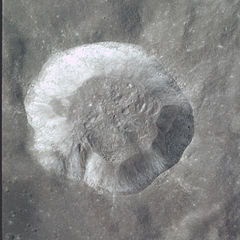Proclus (crater)

Apollo 17 image
|
|
| Coordinates | 16°06′N 46°48′E / 16.1°N 46.8°ECoordinates: 16°06′N 46°48′E / 16.1°N 46.8°E |
|---|---|
| Diameter | 28 km |
| Depth | 2.4 km |
| Colongitude | 314° at sunrise |
| Eponym | Proclus Diadochus |
Proclus is a young lunar impact crater located to the west of the Mare Crisium, on the east shore of the Palus Somni. It lies to the south of the prominent, terraced crater Macrobius, and west-northwest of the lava-flooded Yerkes. Between Proclus and Yerkes, on the edge of the mare, are the Promontories named Olivium and Lavinium.
The rim of Proclus is distinctly polygonal in shape, having the shape of a pentagon, and does not rise very far above the surrounding terrain. It has a high albedo, being second only to Aristarchus in brightness. The interior wall displays some slumping, and the floor is uneven with a few small rises from slump blocks.
The crater has a notable ray system that extends for a distance of over 600 kilometers. The rays display an asymmetry of form, with the most prominent being rays to the northwest, north-northeast, and northeast. There is an arc with no ejecta to the southwest. These features suggest an oblique impact at a low angle. The rays indicate the crater is part of the Copernican System.
A candidate landing site for the Apollo program was located about 100 km north-northeast of Proclus. The site was rejected in favor of the geologically diverse Taurus-Littrow valley for the Apollo 17 mission.
By convention these features are identified on lunar maps by placing the letter on the side of the crater midpoint that is closest to Proclus.
The following craters have been renamed by the IAU.
Proclus D
Proclus G
...
Wikipedia
